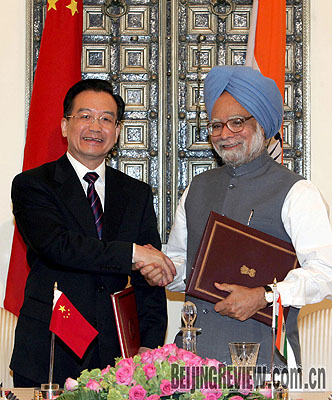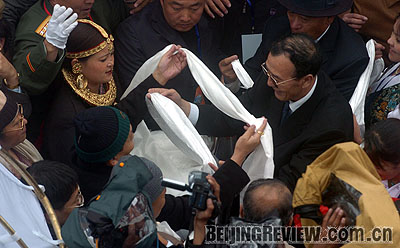|
|

JOINT STATEMENT: Visiting Chinese Premier Wen Jiabao (left) shakes hands with Indian Prime Minister Manmohan Singh after signing a joint statement on political settlement of the boundary issue in New Delhi on April 11, 2005 (LI XUEREN) |
On November 8, Indian External Affairs Minister Pranab Mukherjee appeared at an event in the so-called "Arunachal Pradesh," India's easternmost state and the subject of a border dispute with China. In a speech, he stated that the so-called "Arunachal Pradesh" was an inseparable part of Indian territory, suggesting that China open the border there for trade.
A Chinese Foreign Ministry spokesman disputed Mukherjee's remarks, which he said ignore historical facts. Spokesman Qin Gang said the two countries had never officially mapped out their borders. "China's position on the eastern part of the border between the two countries is consistent and clear," Qin said. "Throughout history, China has never recognized the illegal 'McMahon Line.' The Indian side is well aware of this position."
The spokesman reiterated China's willingness to negotiate with India for a fair and reasonable solution that is acceptable to both sides.
A decades-long dispute
China has land and sea boundary issues with 14 neighbors, mostly for historical reasons. The Chinese Government takes a cautious approach to solving border disputes by following basic principles and constantly updating related policies.
The government aims to maintain current border situations until final settlement. China's position is that the countries involved should solve border disputes through peaceful negotiation instead of appealing to arms. During these negotiations, related sides must consider both historical background and the existing situation. To reach consensus, related sides may make necessary adjustments to their borders.
|
 CROSS-BORDER MARKET: Chinese and Indian officials pay their respects to each other at a ceremony celebrating the reopening of the Nathu La market on the China-India border on July 6, 2007 (HAN CHUANHAO)
CROSS-BORDER MARKET: Chinese and Indian officials pay their respects to each other at a ceremony celebrating the reopening of the Nathu La market on the China-India border on July 6, 2007 (HAN CHUANHAO) | The so-called "Arunachal Pradesh" dispute is China's most intractable border issue. Because the gap between the positions of China and India is wide, it is difficult for both nations to reach consensus. But Chinese leaders of different generations have never lost patience, making efforts to enhance mutual trust and dispel suspicions in order to achieve a peaceful solution.
China and India share a 2,000-km border, divided into three parts by Nepal and Bhutan. They have clashed over several areas covering about 125,000 square km. In 1914, Britain drew the "McMahon Line," separating Tibet Autonomous Region and India in the border's eastern section and plotting 90,000 square km of Chinese territory on the southern slope of the Himalayas into British India. When India gained independence in 1947, it inherited the disputed territory as well. China has always considered the "McMahon Line" invalid.
In 1959, India officially brought forward territory demands along the western part of the China-India border, including 33,000 square km in the Aksai Chin area in China's Xinjiang Uygur Autonomous Region. Finally, the disputed area in the border's middle section covers an area of 2,000 square km, which is under Indian control.
|
